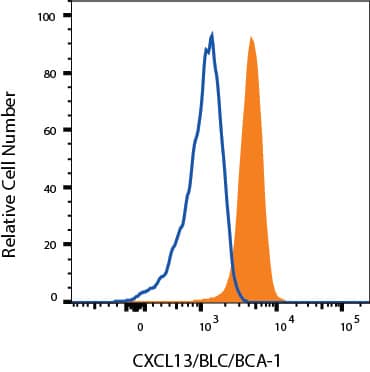Human CXCL13/BLC/BCA-1 Antibody
R&D Systems, part of Bio-Techne | Catalog # MAB8012


Key Product Details
Validated by
Species Reactivity
Validated:
Cited:
Applications
Validated:
Cited:
Label
Antibody Source
Product Specifications
Immunogen
Val23-Arg94
Accession # O43927
Specificity
Clonality
Host
Isotype
Endotoxin Level
Scientific Data Images for Human CXCL13/BLC/BCA-1 Antibody
CXCL13/BLC/BCA-1 in Human Tonsil.
CXCL13/BLC/BCA-1 was detected in immersion fixed paraffin-embedded sections of human tonsil using Mouse Anti-Human CXCL13/BLC/BCA-1 Monoclonal Antibody (Catalog # MAB8012) at 1.7 µg/mL for 1 hour at room temperature followed by incubation with the Anti-Mouse IgG VisUCyte™ HRP Polymer Antibody VC001). Before incubation with the primary antibody, tissue was subjected to heat-induced epitope retrieval using Antigen Retrieval Reagent-Basic (CTS013). Tissue was stained using DAB (brown) and counterstained with hematoxylin (blue). Specific staining was localized to cytoplasm. View our protocol for IHC Staining with VisUCyte HRP Polymer Detection Reagents.Chemotaxis Induced by CXCL13/BLC/BCA-1 and Neutralization by Human CXCL13/BLC/BCA-1 Antibody.
Recombinant Human CXCL13/BLC/BCA-1 (801-CX) chemoattracts the BaF3 mouse pro-B cell line transfected with human CXCR5 in a dose-dependent manner (orange line). The amount of cells that migrated through to the lower chemotaxis chamber was measured by Resazurin (AR002). Chemotaxis elicited by Recombinant Human CXCL13/BLC/BCA-1 (0.05 µg/mL) is neutralized (green line) by increasing concentrations of Mouse Anti-Human CXCL13/BLC/BCA-1 Monoclonal Antibody (Catalog # MAB8012). The ND50 is typically 0.5-2.5 µg/mL.Detection of CXCL13/BLC/BCA-1 in Immature dendritic cells by Flow Cytometry.
Immature dendritic cells (CD14 selected PBMCs are treated with 20 ng/mL Recombinant Human IL-4 Protein (204-IL) and 50 ng/mL Recombinant Human GM-CSF Protein (215-GM) for 6 days) were stained with Mouse Anti-Human CXCL13/BLC/BCA-1 Monoclonal Antibody (Catalog # MAB8012, filled histogram) or isotype control antibody (Catalog # MAB002, open histogram), followed by Allophycocyanin-conjugated Anti-Mouse IgG Secondary Antibody (Catalog # F0101B). To facilitate intracellular staining, cells were fixed and permeabilized with FlowX FoxP3 Fixation & Permeabilization Buffer Kit (FC012). View our protocol for Staining Intracellular Molecules.Applications for Human CXCL13/BLC/BCA-1 Antibody
Immunohistochemistry
Sample: Immersion fixed paraffin-embedded sections of human tonsil tissue
Intracellular Staining by Flow Cytometry
Sample: Immature Dendritic cells were used (CD14 selected PBMCs are treated with 20 ng/mL rhIL-4 (Catalog # 204-IL) and 50 ng/mL rhGM-CSF (Catalog # 215-GM) for 6 days) and TT human medullary thyroid cancer cells
Neutralization
Formulation, Preparation, and Storage
Purification
Reconstitution
Formulation
Shipping
Stability & Storage
- 12 months from date of receipt, -20 to -70 °C as supplied.
- 1 month, 2 to 8 °C under sterile conditions after reconstitution.
- 6 months, -20 to -70 °C under sterile conditions after reconstitution.
Background: CXCL13/BLC/BCA-1
CXCL13, also known as B-lymphocyte chemoattractant (BLC), is a CXC chemokine that is constitutively expressed in secondary lymphoid organs. BCA-1 cDNA encodes a protein of 109 amino acid residues with a leader sequence of 22 residues. Mature human BCA-1 shares 64% amino acid sequence similarity with the mouse protein and 23-34% amino acid sequence identity with other known CXC chemokines. Recombinant or chemically synthesized BCA-1 is a potent chemoattractant for B lymphocytes but not T lymphocytes, monocytes or neutrophils. BLR1, a G protein-coupled receptor originally isolated from Burkitt’s lymphoma cells, has now been shown to be the specific receptor for BCA-1. Among cells of the hematopoietic lineages, the expression of BLR1, now designated CXCR5, is restricted to B lymphocytes and a subpopulation of T helper memory cells. Mice lacking BLR1 have been shown to lack inguinal lymph nodes. These mice were also found to have impaired development of Peyer’s patches and defective formation of primary follicles and germinal centers in the spleen as a result of the inability of B lymphocytes to migrate into B cell areas.
References
- Gunn, M.D. et al. (1998) Nature, 391:799.
- Legler, D.F. et al. (1998) J. Exp. Med. 187:655.
- Forster, R. et al. (1996) Cell 87:1037.
Alternate Names
Gene Symbol
UniProt
Additional CXCL13/BLC/BCA-1 Products
Product Documents for Human CXCL13/BLC/BCA-1 Antibody
Product Specific Notices for Human CXCL13/BLC/BCA-1 Antibody
For research use only



